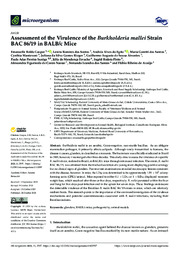Assessment of the virulence of the Burkholderia mallei Strain BAC 86/19 in BALB/c Mice.
Assessment of the virulence of the Burkholderia mallei Strain BAC 86/19 in BALB/c Mice.
Autoria: GASPAR, E. B.; SANTOS, L. R. dos; EGITO, A. A. do; SANTOS, M. G. dos; MANTOVANI, C.; RIEGER, J. DA S. G.; ABRANTES, G. A. DE S.; SUNIGA, P. A. P.; FAVACHO, J. DE M.; PINTO, I. B.; NASSAR, A. F. DE C.; SANTOS, F. L. DOS; ARAUJO, F. R.
Resumo: ABSTRACT - Burkholderia mallei is an aerobic, Gram-negative, non-motile bacillus. As an obligate mammalian pathogen, it primarily affects solipeds. Although rarely transmitted to humans, the disease it causes, glanders, is classified as a zoonosis. The bacterium was officially eradicated in Brazil in 1969; however, it reemerged after three decades. This study aims to assess the virulence of a specific B. mallei strain, isolated in Brazil, in BALB/c mice through intranasal infection. The strain, B. mallei BAC 86/19, was obtained from the tracheal secretion of a young mare displaying positive serology but no clinical signs of glanders. Post-mortem examinations revealed macroscopic lesions consistent with the disease, however. In mice, the LD50 was determined to be approximately 1.59 × 105 colony-forming units (CFU)/animal. Mice exposed to either 0.1 × LD50 or 1 × LD50 displayed transient weight loss, which resolved after three or five days, respectively. B. mallei persisted within the liver and lung for five days post-infection and in the spleen for seven days. These findings underscore the detectable virulence of the Brazilian B. mallei BAC 86/19 strain in mice, which are relatively resilient hosts. This research points to the importance of the continued investigation of the virulence mechanisms and potential countermeasures associated with B. mallei infections, including their Brazilian isolates.
Ano de publicação: 2023
Tipo de publicação: Artigo de periódico
Unidade: Embrapa Pecuária Sul
Palavras-chave: Animal diseases, Animal models, Burkholderia mallei, Doença Animal, Glanders, Pathogenicity, Virulence, Zoonose, Zoonoses
Observações
1 - Por padrão são exibidas publicações dos últimos 20 anos. Para encontrar publicações mais antigas, configure o filtro ano de publicação, colocando o ano a partir do qual você deseja encontrar publicações. O filtro está na coluna da esquerda na busca acima.
2 - Para ler algumas publicações da Embrapa (apenas as que estão em formato ePub), é necessário ter, no celular ou computador, um desses softwares gratuitos. Sistemas Android: Google Play Livros; IOS: iBooks; Windows e Linux: software Calibre.
Acesse outras publicações
Acesse a Base de Dados da Pesquisa Agropecuária (BDPA) para consultar o acervo completo das bibliotecas da Embrapa.

